Primary sources and abbreviations:
Buranelli
Laocoonte. Alle origini dei Musei Vaticani, edited by Francesco Buranelli, Paolo Liverani, Arnold Nesselrath (Rome 2006) 119–200.
Haskell-Penny= Francis Haskell and Nicholas Penny.
Taste and the Antique (New Haven: Yale University Press, 1981) 243–247.
Pinelli= Orietta Rossi Pinelli,
Chirurgia della memoria: scultura antica e restauri storici,\
in Memoria dell'antico nell'arte italiana, ed. Salvatore Settis (Turin: G. Einaudi, 1986) III.183–191.
40–20 CE
Probable period in which the "Laocoon" group was sculpted by Agesander, Polydorus, and Athenodorus of Rhodes. The dating of the group is still a matter of debate among specialists. The following dates have been proposed:
- Mid-second Century BCE: Filippo Magi, Il ripristino del Laocoonte, in Atti della Pontifica Accademia Romana di Archeologia, Memorie III.9.1. (Vatican City, 1960).
- 40–20 CE: Salvatore Settis, Laocoonte. Fama e stile (Rome 1999).
- 14–37 CE: Copy of a bronze datable to ca. 140 BCE in the Pergamene style; Bernard Andreae, Laokoon und die Gründung Roms (Mainz 1988); Praetorium Speluncae. Tiberius und Ovid in Sperlonga, Abhandlungen der Geistes- und Sozialwissenschaftlichen Klasse, Jahrgang 1994, Nr. 12, Akademie der Wissenschaften und der Literatur (Mainz, Stuttgart 1994).
- 41–68 CE: Original work inspired by late-Classical and especially Hellenistic precedents; Nikolaus Himmelmann, "Laokoon," Antike Kunst 34 (1991) 97–115; Sperlonga. Die homerischen Gruppen und ihre Bildquellen (Opladen 1995).
70s CE: "Laocoon" group recorded in the home of the Emperor Titus by Pliny the Elder (Natural History 36.37). Text:
Latin:
"Nec deinde multo plurimum fama est, quorundam claritati in operibus eximiis obstante numero artificum, quoniam nec unus occupat gloriam nec plures pariter nuncupari possunt, sicut in Laocoonte, qui est in Titi imperatoris domo, opus omnibus et picturae et statuariae artis praeferendum. ex uno lapide eum ac liberos draconumque mirabiles nexus de consilii sententia fecere summi artifices Hagesander et Polydorus et Athenodorus Rhodii" (ed. Carolus Mayhoff, Leipzig, Teubner 1897).
English translation: "Beyond these, there are not many sculptors of high repute; for, in the case of several works of very great excellence, the number of artists that have been engaged upon them has proved a considerable obstacle to the fame of each, no individual being able to engross the whole of the credit, and it being impossible to award it in due proportion to the names of the several artists combined. Such is the case with the Laocoon, for example, in the palace of the Emperor Titus, a work that may be looked upon as preferable to any other production of the art of painting or of statuary. It is sculptured from a single block, both the main figure as well as the children, and the serpents with their marvelous folds. This group was made in concert by three most eminent artists, Agesander, Polydorus, and Athenodorus, natives of Rhodes" (translated by ed. John Bostock, M.D., F.R.S., H.T. Riley, Esq., B.A.).
January 13 or 14, 1506:
The "Laocoon" statue group was found on the Oppian Hill, under the remains of the Baths of Titus at a site called "Le Capocce," in a vineyard on the Esquiline worked by a certain Felice de' Freddis.
It was found "sotto terra circa braccia 6" (Buranelli, 129 [nr. 16]).
On the location and on de" Freddi (or, in Latinized form, "de Freddis") see Rita Volpe and Antonella Parisi, Laocoonte. L'ultimo engima," in Archeo 299, January 2010, pp. 26-39.
Giulio II sent Giuliano da Sangallo, his son Francesco and Michelangelo to see the discovery.
It was immediately identified by Giuliano da Sangallo as the famous group praised by Pliny in Natural History 36.37. For an account of the identification by Francesco da Sangallo, see February 28, 1567. Almost immediately, it was noticed that (contrary to Pliny's description) the "Laocoon" was not carved from a single block of marble.
Various explanations were advanced, but through the centuries few scholars have doubted that this "Laocoon" corresponds to the statue group reported by Pliny (for details, see Haskell-Penny, 246). Of the skeptics, perhaps the most worth reading is Giuseppe Lugli, "La Domus Titi e la scopeta del Laocoonte," Archeologia Classica 10 (1958) 197–200, who argues that the Domus Imperatoris Titi was on the Quirinal and that the "Laocoon" found in 1506 was an ancient copy.
March 23, 1506:
Giulio II purchased the "Laocoon" from Felice de" Freddis. Source (with transcription of the sales agreement): Buranelli, 130 (nr. 16).
March–June 1506.
Transfer of the "Laocoon" to the Vatican. Source: Buranelli, 126 (nr. 12).
Beginning of August, 1506.
Transfer of the "Laocoon" to the Vatican
Villa Bel-Vedere, originally a rectangular garden courtyard.
The statue group is placed in the
"Villetta di Belvedere"
"[in] a special space like a chapel," i.e., in the central niche in the south wall of the Cortile between the Apollo del Bel-Vedere and the Venere.
"Thus Giulio II believed that he was fulfilling a divine mission to give the world a lasting order through spiritual renewal just as Anchises, according to Virgil, sent Aeneas on his way from Troy to carry out his mission for Rome:
"Bring peace to all men," Georg Daltrop,
"The Belvedere," in The Vatican Collections. The Papacy and Art (New York 1982) 57–61 at p. 58.
Source for the date:
Grossino, letter to Isabella d'Este dated 16 August 1506:
Il papa ha fato lever il Lacounti dove era e l'a fato portar in la corte di Belveder dove è una bella Venere et l'Apolo.
(quoted by S. Maffei, "La fama di Laocoonte nei testi del Cinquecento," in Laocoonte. Fama e stile, edited by S. Settis [Rome 1999] 173).
Source for the location of the "Laocoon" in the Cortile, Tatiana Bartsch in Buranelli, 127 (nr. 12).
For the niche see Arnold Nesselrath in Buranelli, 145 (nr. 33).
1506–1508 (a).
First illustration of the "Laocoon" drawn by Giovanni Antonio da Brescia (figure 1).
For the attribution of the drawing, see Arnold Nesselrath, Hochrenaissance im Vatikan. Kunst und Kultur im Rom der Päpste, Exhibition, Bonn 1998–1999, edited by P. Kruse (Ostfildern, Verlag Gerd Hatje, 1998) cat. 234. The drawing attests that the group was found in good condition. The missing parts include the right arm of the father and the younger son, the older son's right hand, as well as some of the snake's coils. Da Brescia was an artist in the circle of Mantegna. After the latter's death on September 13, 1506, da Brescia moved to Rome, where he worked until 1525. The date of the view is based on the condition of the "Laocoon," which has not yet been placed on its new pedestal in the Cortile delle Statue (cf. fig. 3), an event that occurred in 1511; cf. Tatiana Bartsch in Buranelli, 127 (nr. 12).
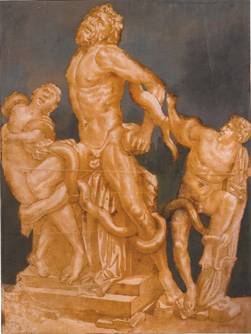
Giovanni Antonio da Brescia, between January 14, 1506 and 1508. Düsseldorf, museum kunst palest, inventory nr. KA (FP) 7032.
1506–1508 (b).
Copper engraving (figure 2) of group by Giovanni Antonio da Brescia (London, British Museum, inventory 1845-8-25-707). This is one of several views dating to soon after the excavation which confirms the separation of the elder son from the other two figures at the time of their discovery. Pinelli (Pinelli) notes that "the frontal arrangement of the group is thus a sixteenth-century reconstruction that perhaps has nothing to do with the original composition of the Rhodian work." Seymour Howard ("On the Reconstruction of the Vatican Laocoon Group," American Journal of Archaeology 63 (1959) 365–369) made a similar point on the basis of autopsy of the marble (see below under 1959).
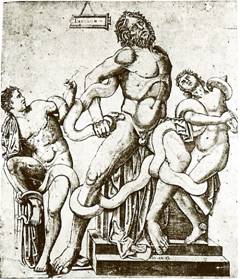
Giovanni Antonio da Brescia, copper engraving of "Laocoon," ca. 1506–1508 (London, British Museum, inventory 1845-8-25-707). See Tatiana Bartsch in Buranelli, 126–127 (nr. 12).
1509/1510 (ca.). "Laocoon" drawn by Marcantonio Raimondi. Pen with brown ink. Budapest, Museum of Fine Art, inv. 58.983. Illustrated in Buranelli, 145 (nr. 33). The interest of the drawing is that it shows that by this time the statue group was still largely unrestored: only the foot and right knee of the younger son (which were found separated from the statue) have been integrated, as noted by Arnold Nesselrath, Buranelli, 145 (nr. 33).
1510. Jacopo Sansovino makes a copy of the group in wax, which is used to make a bronze copy for Cardinal Domenico Grimani. The copy is now lost (see Isabella Leone in Buranelli, 138 [nr. 25]). Source: Giorgio Vasari, Le vite de' più eccellenti architetti, pittori e scultori italiani, da Cimabue insino a' tempi nostri (Florence: n.p., 1550; reprint, Florence: Appresso I Giunti, 1568; edition used: Gaetano Milanesi, editor, vol. 7 [Florence: G.C. Sansoni, 1878–1885]) 489: "Becoming known for these reasons to all the craftsmen of Florence, and being considered a young man of fine parts and excellent character, Jacopo was taken to Rome by Giuliano da San Gallo, architect to Pope Julius II, vastly to his satisfaction; and then, taking extraordinary pleasure in the ancient statues that are in the Belvedere, he set himself to draw them. Whereupon Bramante, who was likewise architect to Pope Julius, holding the first place at that time and dwelling in the Belvedere, having seen some drawings by this young man, and a nude recumbent figure of clay in full-relief, holding a vessel to contain ink, which he had made, liked them so much that he took him under his protection and ordered him that he should make a large copy in wax of the Laocoon, which he was having copied also by others, in order to take a cast in bronze—namely, by Zaccheria Zacchi of Volterra, the Spaniard Alonzo Berughetta, and Vecchio of Bologna" (derived from the translation of Gaston C. DeVere, 1912/1915 and accessed online August 30, 2009 at: www.efn.org/~acd/vite/VasariJSan.html).
Ca. 1520–1525. Baccio Bandinelli makes bronze copy (figure 3) and a (now lost) restoration of the father's right arm in wax. Source: Giorgio Vasari, Le vite de' più eccellenti architetti, pittori e scultori italiani, da Cimabue insino a' tempi nostri (Florence: n.p., 1550; reprint, Florence: Appresso I Giunti, 1568; edition used: Gaetano Milanesi, editor, vol. 6 [Florence: G.C. Sansoni, 1878–1885]) 146, 632: "Cardinal Bernardo Divizio of Bibbiena had recently returned from France. Perceiving that King Francis possessed not a single work in marble, whether ancient or modern, although he much delighted in such things, Cardinal Divizio had promised his Majesty that he would prevail on the Pope to send him some beautiful work. After this Cardinal there came to the Pope two Ambassadors from King Francis, and they, after seeing the statues of the Belvedere, lavished all the praise at their command on the Laocoon. Cardinals de Medici and Bibbiena, who were with them, asked them whether the King would be glad to have a work of that kind; and they answered that it would be too great a gift. Then the Cardinal said to them: There shall be sent to his Majesty either this one or one so like it that there shall be no difference. And, having resolved to have a replica made of it, he remembered Baccio, whom he sent for and asked whether he had the courage to make a Laocoon equal to the original. Baccio answered that he was confident that he could make one not merely equal to it, but even surpassing it in perfection. The Cardinal then resolved that the work should be begun, and Baccio, while waiting for the marble to come, made one in wax, which was much extolled, and also executed a cartoon in lead-white and charcoal of the same size as the one in marble. After the marble had come and Baccio had caused an enclosure with a roof for working in to be erected for himself in the Belvedere, he made a beginning with one of the boys of the Laocoon, the larger one, and executed this in such a manner that the Pope and all those who were good judges were satisfied, because between his work and the ancient there was scarcely any difference to be seen. But after setting his hand to the other boy and to the statue of the father, which is in the middle, he had not gone far when the Pope died [Leo X died Dec. 1, 1521]. Adrian VI being then elected, he returned with the Cardinal to Florence, where he occupied himself with his studies in design. After the death of Adrian and the election of Clement VII, Baccio went post-haste to Rome in order to be in time for his coronation, for which he made statues and scenes in half relief by order of his Holiness. Then, having been provided by the Pope with rooms and an allowance, he returned to his Laocoon, a work which was executed by him in the space of two years with the greatest excellence that he ever achieved. He also restored the right arm of the ancient Laocoon, which had been broken off and never found, and Baccio made one of the full size in wax, which so resembled the ancient work in the muscles, in force, and in manner, and harmonized with it so well, that it showed how Baccio understood his art; and this model served him as a pattern for making the whole arm of his own Laocoon. This work seemed to his Holiness to be so good, that he changed his mind and resolved to send other ancient statues to the King, and this one to Florence; and to Cardinal Silvio Passerino of Cortona, his Legate in Florence, who was then governing the city, he sent orders that he should place the Laocoon at the head of the second court in the Palace of the Medici. This was in the year 1525. This work brought great fame to Baccio." (derived from the translation of Gaston C. DeVere, 1912/1915 and accessed online August 30, 2009 at: www.efn.org/~acd/vite/VasariBandin1.html).

"Laocoon" by Baccio Bandinelli, Uffizi, Florence. Cardinal Giulio dei Medici (later Pope Clement VII, 1523–1534) commissioned the marble group Bandinelli (1493–1560) in 1520. Intended as a gift for Francis I, King of France, the sculpture was made from three blocks of marble. It was sent from Rome to Florence in 1531 and put into the courtyard of the Palazzo Medici on Via Larga, as indicated in the inscription on the base added in 1779. It was later moved to the Casino of S. Marco and probably set up in its present position in the Uffizi in 1671. Source: www.davisefranceschini.it/home/wpcontent/uploads/2008/07/laooconte1.jpg (accessed August 30, 2009).
1521. Sansovino made a bronze miniature of the "Laocoon," now in the Victoria and Albert Museum, Salting bequest, inv. A 136-1910. The interest of this copy lies in the fact that Sansovino followed Bandinelli in restoring the right arm of the father as bent back toward the head. For illustration and discussion see Isabella Leone in Buranelli, 137 (nr. 24).
1532.
Giovanni Antonio Montorsoli, a former assistant of Michelangelo, restores the "broken statues" of the Belvedere, including the Laocoon (figure 4) and Apollo. The reason for the restoration is not known. Note that in contrast to Bandinelli's copy, where the father's right arm (restored in terracotta; see Haskell-Penny, 246) bends back slightly toward his head, Montorsoli's restoration shows the father's right arm pointing upward, away from the head. Assuming that Bandinelli's wax right arm of the father was attached to the original and that it corresponds to the bronze version in Florence, it is unclear why Montorsoli changed its orientation, especially since Montorsoli was working for the same pope (Clement VII) who had admired Bandinelli's version. Pinelli (Pinelli) interprets Montorsoli's hitherto unattested positioning of the arm as a "great emphatic gesture, more apt to show non-submissive pain—an attempt at rebellion against the undeserved punishment." Pinelli also notes (ibid.) that "ever since its first appearance, Montorsoli's invented gesture, along with the priest's suffering features, became the expressive hallmark of the entire group and, consequently, was an extraordinary penetrating force in contemporary and later figurative culture. The great theatrical gesture of the Laocoon, though arousing not a few misgivings in terms of its archaeological accuracy, was generally liked and remained associated with the image of the statue until the years following World War II." Source: Giorgio Vasari, Le vite, 632. At the beginning of the nineteenth century, on the basis of a vague reference by Michelangelo, Montorsoli's arm was erroneously attributed to Bernini. See G. G. De Rossi, "Lettera sopra il restauro di una antica statua di Antinoo, e sopra il restauro degli antichi marmi nei tre secoli precedent al nostro," Nuovo Giornale dei Letterati 13 (1826) 23–38.
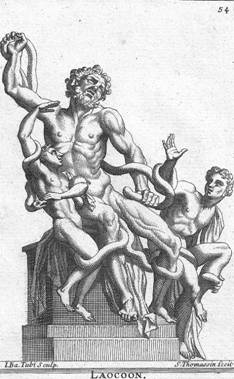
Engraving by Simon Thomassin (1654–1733), 1694. The engraving shows Montorsoli's restoration. Source: private collection.
1540 (ca.). Francesco Primaticcio creates a bronze cast for the cast collection commissioned by Francis I (figure 5). Montorsoli's integrations are missing. Two reasons for this have been suggested. Brummer (The Statue Court in the Vatican Belvedere [Stockholm 1970]) suggests that the terracotta arm had been temporarily removed. Pinelli (Pinelli), arguing that Brummer's scenario is unlikely, argues for a conscious choice on the part of Primaticcio: he might have disagreed with Montorsoli's restoration; or he may have wished to "copy the Laocoon with its original gaps"[as] a tribute to the taste, still strong north of the Alps in the 1540s, for ruins and the fragment." Source: Giorgio Vasari, Le vite: "Liking the manner of this painter, and his procedure in every matter, the King sent him in the year 1540 to Rome, to contrive to obtain certain antique marbles; in which Primaticcio served him with such diligence, that in a short time, what with heads, torsi, and figures, he bought one hundred and twenty-five pieces. And at that same time he caused to be molded by Jacopo Barozzi of Vignuola, and by others, the bronze horse that is on the Campidoglio, a great part of the scenes on the Column, the statue of Commodus, the Venus, the Laocoon, the Tiber, the Nile, and the statue of Cleopatra, which are in the Belvedere; to the end that they might all be cast in bronze. Rosso having meanwhile died in France, and a long gallery therefore remaining unfinished which had been begun after his designs and in great part adorned with stucco work and pictures, Primaticcio was recalled from Rome; whereupon he took ship with the above-mentioned marbles and moulds of antique figures, and returned to France. There, before any other thing, he cast according to those moulds and forms a great part of those antique figures, which came out so well, that they might be the originals; as may be seen in the Queen's garden at Fontainebleau, where they were placed, to the vast satisfaction of that King, who made in that place, one might say, another Rome. I will not omit to say that Primaticcio, in executing those statues, employed masters so excellent in the art of casting, that those works came out not only light, but with a surface so smooth, that it was hardly necessary to polish them" (derived from the translation of Gaston C. DeVere, 1912/1915 and accessed online August 30, 2009 at: www.efn.org/~acd/vite/VasariPrimaticcio.html).
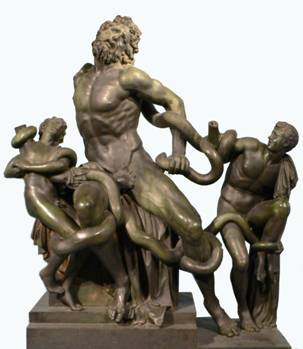
Francesco Primaticcio, Laocoon, bronze copy, 1543. Fontainebleau, Musee National du Chateau, since 1968 in storage in the Louvre, inv. MR 3290. Photograph: Bernard Frischer.
February 28, 1567. Francesco da Sangallo writes letter to Vincenzo Maria Borghini in which the discovery of the "Laocoon" in 1506 is described. Text: "La notitia ch'io ho delle Statue Antiche di Fiorenza, si è in questo modo: che io era di pochi anni la prima uolta ch'io fui a Roma, che fu detto al Papa che in una vigna presso a Santa Maria Maggiore s'era trouato certe Statue molto belle; el Papa comandò a un palafreniere, "va et di" a' Giuliano da S. Gallo che subito la uadia a uedere," et così subito s'andò; et per che Michelangelo Bonarroti si trouaua continuamente in casa, che mio Padre l'haueua fatto uenire, et gli haueua allogata le Sepoltura del P(a)P(a); et uolle che ancor Lui andasse, ed io così in groppa a mio Padre, et andamo; et scesi doue erano le Statue, subito mio Padre disse: "questa e' Hilaoconte che fa mentione Plinio"; et si fece crescere la buca, per poterlo tirar fuora, et uisto, ci tornamo a desinare, et sempre si ragionò d(e)lle cose Antiche, discorrendo anc(or)a di quelle di Fior(en)za." Source: Buranelli, 127–128 (number 13).
1725–1727. Agostino Cornacchini modified the Montorsoli gesture of the younger son by extending the right arm upwards (figure 6), clearly recalling the father's gesture. Pinelli (Pinelli) notes that "this certainly seems to be a choice that derives from a strictly compositional interest, and one that contradicts the standard interpretation of the figure as the one closest to death."
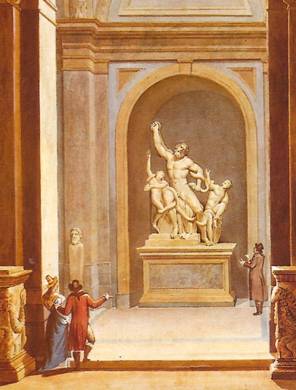
Detail of a view of the Cortile del Belvedere with Laocoon, hand-colored etching by Louis Ducros and Giovanni Volpato, 1787–1792.
In this etching, we see the Laocoon as restored by Cornacchini. Note how the right arm of the younger son, like that of his father, is lifted upward. Photograph from Andrew Wilton and Ilaria Bignamini, editors. Grand Tour. The Lure of Italy in the Eighteenth Century (London: Tate Gallery Publishing, 1996) 248 (nr. 201).
1750–1770 (ca.). Raphael Mengs commissioned casts of the Laocoon; one is now in the Academy of Fine Arts in Florence (see Pinelli), the other (figure 7) is in Dresden. Both show the gesture of the dying younger son as it appeared prior to Cornacchini's intervention. Moreover, as Pinelli notes about the cast in Florence, "the figure of the older son is turned with its back to the father, establishing a more vivid and decipherable relationship in the exchange of glances among the three protagonists and inspiring a new compositional arrangement that is highly suggestive." She recalls, in this connection, the early drawings of 1506–1508 that show that when first found, the figure of the elder son was detached from rest of the piece (see above under 1506–1508 [b]).
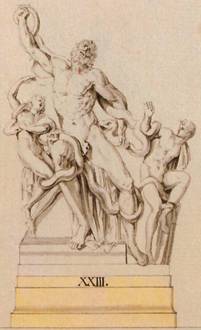
Die Sammlung der Gisabgüsse von Anton Raphael Mengs in Dresden, edited by Moritz Kiderlen [Dresden 2006] 95, table 6 (nr. XXIII), from Jean Gottlob Matthaei, Catalogue des jets de stuc des plus excellentes Antiques en figures, bas-reliefs, têtes, mains, pies etc. (Dresden 1794).
1772. Under Pope Clement XIV, Michelangelo Simonetti is commissioned to transform the Cortile del Belvedere into space that is octagonal in plan. Source: Guide to the Vatican Museums (Vatican City, 2005) 46.
July, 1798.
"Laocoon" taken to Paris under the terms of the Treaty of Tolentino (February 1797) and placed in the Musée Central des Arts when it opened on November 9, 1800. The modern arms were removed and left in Rome. In Paris, a competition was held for a new restoration, but no one entered. The "Laocoon" was thus restored with the plaster arms that the sculptor Girardon had made on returning from his journey to Rome at the end of the seventeenth century (figures 8a, b). As Pinelli (Pinelli) notes regarding the father's right arm, "at this point it is worth recalling Winckelmann's judgment: "this arm, entangled by the snake, must have been folded over the head of the statue,"yet it looks as if the arm folded above the head would have in some way made the work wrong;"" Johann Joachim Winckelmann, Storia delle arti del disegno presso gli antichi, ed. Carlo Fea, vol. 2 (Rome: Dalla stamperia Pagliarini, 1783–1784) 242. Source: Haskell-Penny, 243; E. Michon, Monuments et memoires, Fondation Eugène Piot 21 (Paris: E. Leroux, 1913) 13; "La Restauration du Laocoon et le modèle de Girardon," Bulletin de la Société Nationale des Antiquaires de France (1906); Paul Reinhold Wescher, Kunstraub unter Napoleon (Berlin: Mann, 1976); E. Michon, "La restauration du Laocoon et le modèle de Girardon," Bulletin de la Société Nationale des Antiquaires de France (1906) 272–273; "La Vénus d'Arles et sa restoration par Girardon," Monuments et memoires publiés par l'Académie des inscriptions et Belles-Lettres 21 (1913) 13ff.
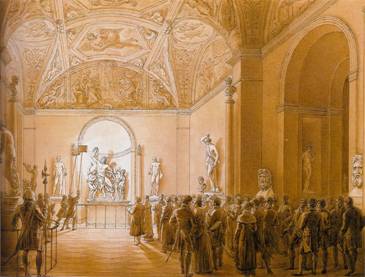
Benjamin Zix, Salle de Laocoon, Paris, ca. 1800. Source: Lacoonte. Alle origini dei Musei Vaticani (Rome: L'Erma di Bretschneider, 2006) 59 (fig. 26).
October 1815. With Napoleon's defeat at Waterloo on June 18, 1815, "Laocoon" (like most of the other works of art looted by the French from Roman and other collections) begins the return trip home from Paris. Source: Haskell-Penny, 243.
January 4, 1816. "Laocoon" returned to the Vatican. In February, it is placed in the Belvedere (Haskell-Penny, 243), not into its original niche, but into the spot formerly occupied by Venus Felix (Filippo Magi, Il ripristino del Laocoonte, Atti della Pontificia Accademia Romana di Archeologia, Memorie s. III.9.1. [Vatican City 1960] 8). Canova restores Montorsoli's and Cornacchini's supplements (figure 9). Canova knew that these additions were erroneous, but he wrote to Gherardo De Rossi that replacing the old restorations "would have caused contention and debate among antiquarians and artists and trouble for himself without any advantage." Gherardo De Rossi, "Lettera sopra il restauro di un'antica statua di Antinoo, e sopra il restauro degli antichi marmi nei tre secoli precedent al nostro," Nuovo Giornale de' Letterati, vol. 13 (Pisa 1926) 23–32 at p. 25.
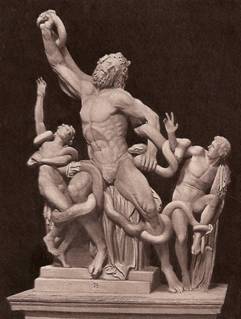
Late 19th century photograph of the Laocoon showing Canova's restoration with Montorsoli's right arm of the father and Cornacchini's right arm of the younger son. Published by Gebbie & Co. Source: private collection.
1819. Ennio Quirino Visconti (Musée Pio-Clementin II [Milan: I.P. Geigler, 1819] 274) mentioned finding in the Vatican an unfinished marble arm traditionally attributed to Michelangelo. Visconti believed that the arm was an early study by Montorsoli, a theory that Pinelli finds unlikely (Pinelli). Filippo Magi, "Il ripristino del Laocoonte," Memorie, Pontificia Accademia Romana di Archeologia 9 (1960), found the same arm in the Vatican. He assumed that it was an incomplete restoration by Michelangelo. Hans Henrik Brummer (The Statue Court in the Vatican Belvedere [Stockholm 1970]) compared the Vatican arm to that on a terracotta of the Laocoon in the Princeton Art Museum. Brummer attributed the terracotta to Sansovino and believed that the arm was an unfinished restoration by Sansovino. Visconti admired the expressiveness of Montorsoli's restoration ("une des meilleures restaurations que l'on voye adaptées à d'antiques sculptures" ["one of the best restorations that has been applied to ancient sculpture"], so that if the ancient arm was to really bend back toward the head, "elle n'aurait pas paru avec tant d'avantage" ["it would not have looked as good"]). Visconti condemned Cornacchini's restoration of the younger son's right arm, "qui par-là lui donne une action insignifiante" ["which gives him an insignificant action"].
1905. Ludwig Pollak publishes his discovery of the father's right arm. The arm was found in a sculptor's shop on the Via Labicana in Rome. Thus the arm had ended up no more than several hundred meters from where the statue group had been found four hundred earlier! Ludwig Pollak, "Der rechte Arm des Laokoon," Römische Mitteilungen 20 (1905) 277–282; see also Paolo Liverani in Buranelli, 192 (nr. 90).
1906. Georg Treu implements Pollak's proposed restoration on a cast in the Albertinum in Dresden; see Ingeborg Raumschüssel, "Zur Rekonstruktion des Laokoon durch Georg Treu," in Das Albertinum vor 100 Jahren. Die Sklupturensammlung Georg Treus (Dresden 1994) 277–280 (illustrated in fig. 2, p. 279).]
1942. Ernesto Vergara Caffarelli reconstructed a plaster cast of the "Laocoon" in the collection of the University of Rome. He added a cast of the arm found by Pollak and made other changes, including moving the group slightly to the left and setting it on an undulating base suggesting beach sand. Source: Paul Åström, "Suggerimento per una nuova ricostruzione del Laocoonte," in Colloqui del Sodalizio, seconda serie, 1968–1970 (Rome) 11–20 at p. 12.
1957. Filippo Magi restores "Laocoon," removing Canova's restorations and adding the father's right arm found by Pollak (figure 10); see Filippo Magi, Il ripristino del Laocoonte, in Atti della Pontifica Accademia Romana di Archeologia, Memorie III.9.1. (Vatican City, 1960). The four corner bays, enclosed by Canova, are returned to the form originally given them by Simonetti.
 Figure 10. Filippo Magi's restoration of the "Laocoon" with the father's right arm found by Pollak by Filippo Magi, 1960. Photograph by Bernard Frischer.
Figure 10. Filippo Magi's restoration of the "Laocoon" with the father's right arm found by Pollak by Filippo Magi, 1960. Photograph by Bernard Frischer.
1959.
Seymour Howard ("On the Reconstruction of the Vatican Laocoon Group," American Journal of Archaeology 63 (1959) 365–369) proposes an alternative reconstruction with a more compact, three-dimensional pyramidal composition of the three figures, on the basis of autopsy of the marble: "as now placed, the son seems fixed by the coils and base that join him and his father in a relief-like plane of action common to the three figures. There is, however, no continuous connection fixing this position. The antique fragments as set into the base are separated between the right foot of the boy and the left foot of the father not only by breaks but by filling marble between the edges, no parts of which will coincide. Moreover, the two feet are crowded together in an unnatural position, indicating that they were originally placed differently".The remnants of the original coils "indicate that the figure of the son should be turned about ninety degrees, i.e. parallel to the right side of the altar".The elder son was displaced perhaps as much as ninety degrees out of his original position, and the axis of the group was shifted about forty-five degrees" (pp. 366, 369). Cf. also Seymour Howard, "Laocoon Rerestored," American Journal of Archaeology 93 (1989) 417–422; Seymour Howard, "On the Reconstruction of the Vatican Laocoon Group," in Antiquity Restored (Vienna 1990) 42–62. For critical reactions to Howard's reconstruction, see Filippo Magi, Il ripristino del Laocoonte, in Atti della Pontifica Accademia Romana di Archeologia, Memorie III.9.1. (Vatican City, 1960) 23–24, 37; Peter von Blanckenhagen, "Laokoön, Sperlonga und Vergil," Archäologischer Anzeiger (1969) 256–276 at p. 265n23; Paul Åström, "Suggerimento per una nuova ricostruzione del Laocoonte," in Colloqui del Sodalizio, seconda serie, 1968–1970 (Rome) 11–20 at p. 13.
1968–1970.
Taking Magi's restoration as a point of departure, Paul Åström, "Suggerimento per una nuova ricostruzione del Laocoonte," in Colloqui del Sodalizio, seconda serie, 1968–1970 (Rome) 11–20, proposes a new reconstruction in which the head of the upper serpent is brought close to the right arm of the father, adducing parallel scenes in the ancient iconography in which the serpent bites the priest on the head. He also cites an expert on snakes who identifies the serpent as a python and reports that pythons often kill their victim by biting the head. The reconstruction also foresees shifting the father's right arm by 9 degrees with respect to the restoration of Magi (p. 18).




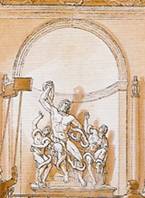

No comments:
Post a Comment